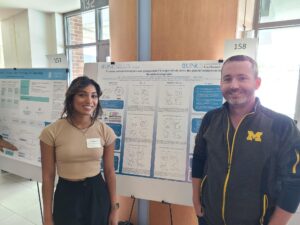
This study, “Protease-activated receptors and glycoprotein VI cooperatively drive the platelet component in thromboelastography”, now in print in JTH with open access, was a collaborative effort between Robert Lee, Wolfgang Bergmeier and other members of the UNC Blood Research Center, and was driven by an outstanding undergraduate student Tanvi Rudran who graduated in 2023. The study addresses critical gaps in knowledge regarding the underlying mechanisms of platelet activation and contraction in a clinical clotting assay, thromboelastography (TEG), which is used to monitor impaired clotting and guide transfusion of blood products. The findings have important implications for interpreting TEG values in bleeding patients.
Abstract
Background: Thromboelastography (TEG) is used for real-time determination of hemostatic status in patients with acute risk of bleeding. Thrombin is thought to drive clotting in TEG through generation of polymerized fibrin and activation of platelets through protease-activated receptors (PARs). However, the specific role of platelet agonist receptors and signaling in TEG has not been reported.
Objectives: Here, we investigated the specific receptors and signaling pathways required for platelet function in TEG using genetic and pharmacologic inhibition of platelet proteins in mouse and human blood samples.
Methods: Clotting parameters (R time, α-angle [α], and maximum amplitude [MA]), were determined in recalcified, kaolin-triggered citrated blood samples using a TEG 5000 analyzer.
Results: We confirmed the requirement of platelets, platelet contraction, and αIIbβ3 integrin function for normal α and MA. Loss of the integrin adaptor Talin1 in megakaryocytes/platelets (Talin1mKO) also reduced α and MA, but only minimal defects were observed in samples from mice lacking Rap1 GTPase signaling. PAR4mKO samples showed impaired α but normal MA. However, impaired TEG traces similar to those in platelet-depleted samples were observed with samples from PAR4mKO mice depleted of glycoprotein VI on platelets or with addition of a Syk inhibitor. We reproduced these results in human blood with combined inhibition of PAR1, PAR4, and Syk.
Conclusion: Our results demonstrate that standard TEG is not sensitive to platelet signaling pathways critical for integrin inside-out activation and platelet hemostatic function. Furthermore, we provide the first evidence that PARs and glycoprotein VI play redundant roles in platelet-mediated clot contraction in TEG.
Pub link
https://www.jthjournal.org/article/S1538-7836(23)00322-7/fulltext
